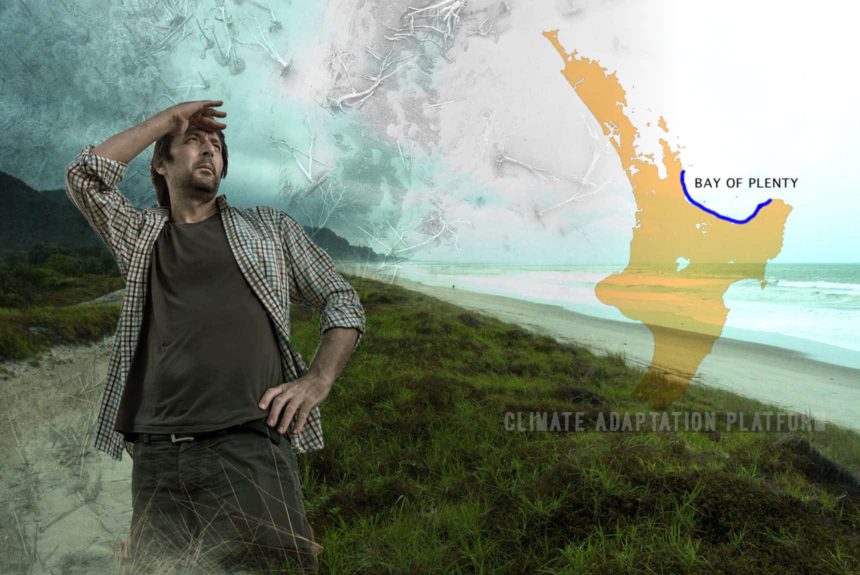As global leaders met for the most critical climate change summit—COP26 in Glasgow—Matatā residents, a coastal New Zealand town, faced managed retreat in the past decade.
Debris swept through their community, and the government has declared it a high-risk area.
Matatā is a town in the Bay of Plenty on the North Island of New Zealand. In May 2005, a once-in-500-year rainfall in the steep catchments behind the town caused debris flows that devastated most of the coastal village (McClure, 2021).
The debris, consisting of huge rocks, trees, sand, silt, and stumps, was wet concrete and destroyed 27 homes, damaging 87 other properties and totalling $20 million in damage (Awatarariki Managed Retreat, n.d.).
The Whakatāne District Council website says that investigation findings from national and international experts regarding the debris flow show that this will happen again, putting the community at high risk.
The district council has initially focused on engineering solutions to protect the residents from future threats. Still, after significant investigations, “engineering experts advised that there were no viable engineering solutions, early warning systems or actively managed processes that would reduce the risks”.
The investigation result has led the council to adopt a “managed retreat” approach as the best solution. The package offers a buy-out scheme for property owners based on their properties’ fair and current market value without any hazard or risk discount applied and provisions for their legal fees, relocation costs, and other applicable fees. Residents were also given timeframes to consider or reject the offer.
When the 31 October 2020 expiration to accept or reject the offer came, some 15 years after the incident, those residents who initially fought the package succumbed and accepted the offer (Macdonald, 2020), except for Greg Fahey. Mr. Fahey lived in a converted container and refused to leave his property, citing that the government’s proposal in 2012 was unfair. Living in his shipping container alone, with his wife taken to a dementia unit a few years ago, he feels that the government owes him compensation for the “years of battles and stress.” Over time, the bad offer has hardened his resistance, seeing it as a much larger injustice. When asked if there is any figure or offer that would change his mind, Fahey responded, “If it was about the money, here, just give us $1.5m and I’m gone. You know what I mean?… But how much is the injustice to be dealt with? What price is that? I’m not leaving without compensation. You don’t treat people like this for 16 years and expect them to walk away on your terms.” (McClure, 2021).
Dr Rob Bell, one of New Zealand’s foremost coastal hazards experts, views the problem in managed retreat as a “socio-political primarily, rather than a technocratic one”, or a much broader set of deeply human and psychological challenges: attachment to place, social and cultural connections, and the structure of communities (McClure, 2021).
He says humans tend to go to great lengths to defend their properties and set up defence strategies – higher sea walls, levees, dams, planting dunes – rather than upping sticks and leaving. And when government funding is available for these projects, residents feel that their investments are validated.
Dr. Judy Lawrence, a researcher studying managed retreat at Victoria University, says these defences can create a false sense of security, called a “levee effect.” People begin to invest and build more properties, but it can generate more devastation and chaos than it might have otherwise been when a breach happens.
Defence strategies may not work in the long run, especially since climate change makes extreme events more frequent and intense (McClure, 2021).
But because people are attached to their property, community, and the area, moving them becomes a politically complex and challenging decision. Leaders tend to postpone the decision as much as possible while waiting for more information.
According to Lawrence, for a management retreat to be successful, it would need clear leadership from local councils. People should also be given options to protect themselves or accept a buy-out if they want to.
What happened in Matatā is an example of how climate change can destroy a once peaceful and tight-knit community, forcing them to leave the area.
It demonstrates how residents and authorities execute a climate adaptation strategy through a managed retreat, how people’s actions can drag the process for many years, and its devastating effect on people.
Source Citation:
McClure, T. (2021, October 2021). Forced retreat: one New Zealand town’s fate highlights coming fight over climate adaptation. The Guardian. Retrieved from https://www.theguardian.com/world/2021/oct/30/forced-retreat-one-new-zealand-towns-fate-highlights-coming-fight-over-climate-adaptation
Awatarariki Managed Retreat Programme. (n.d.). Whakatāne District Council. Retrieved from https://www.whakatane.govt.nz/residents/awatarariki-managed-retreat-programme
Macdonald, N. (2020, December 10). Matatā managed retreat opponents settle ‘reluctantly and under duress’. Stuff. Retrieved from https://www.stuff.co.nz/national/300180689/matat-managed-retreat-opponents-settle-reluctantly-and-under-duress



Leave a Reply